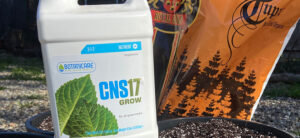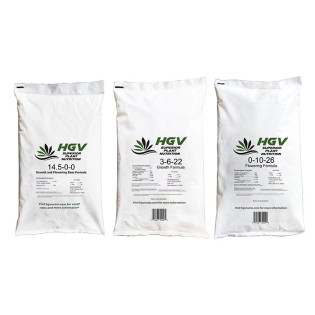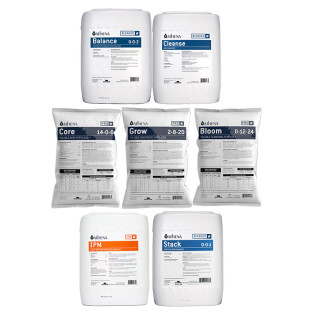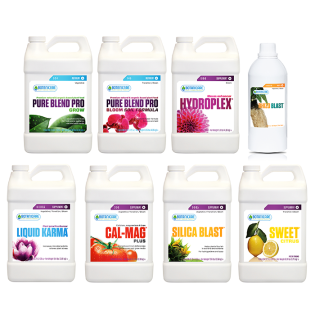
Choosing a line of nutrients to feed your plants with can be a daunting task, especially if you have never grown before.
With hydroponic gardening, nutrients play an especially important role. Plants are grown in a medium that is completely devoid of even trace amounts of the nutrients they need to survive.
This means that the plants depend entirely on the gardener to provide them with the necessary nutrients, in the correct amounts, at the right time in their life cycle.
If the gardener fails to do so, the plants will show signs of nutrient deficiency, such as stunted growth and discoloration, or they may even die completely. Nutrients can be broken down into three categories:
- Macro-nutrients
- Secondary nutrients
- Micro-nutrients
With so many variations in nutrients, from organic to synthetic, veg to bloom, and dry to liquid, where do you even start?
How about we begin by helping you understand each nutrient's role in helping your plants grow and thrive. We will then break down the differences between plant nutrient packages.
Then, we will discuss why pH plays such a vital role in nutrient dosing and plant health.
Macro-nutrients
(N-P-K)
Chances are if you've ever looked at any kind of plant fertilizer or nutrient line, you have noticed three numbers separated by hyphens.
These three values tell us the percentage of each macronutrient contained within the product. The first number represents Nitrogen (N), the second represents Phosphorous (P), and the third is Potassium (K).
As an example, consider a bottle of Cultured Solution's Veg A formula, which is shown on the label to be at (5-0-0.3). This means the product contains 5% nitrogen, 0% phosphorous, and 0.3% potassium.
These values are presented in a clear way on all nutrient-related products because the three nutrients they represent are the most vital for a plant's health, growth, and vigor. These three elements are our primary macronutrients.
Nitrogen (N)
Nitrogen is essential at all stages of a plant's life, but especially so during its vegetative period.
Plants require nitrogen in high amounts during their vegetative state as it promotes photosynthesis, and produces chlorophyll. It is the nutrient responsible for healthy stem and leaf growth and contributes to the plant's vigor and size.

If your plant lacks nitrogen, you will see leaves turn an unpleasant yellow color, as they lack the ability to create chlorophyll, plant growth will slow dramatically as well.
Phosphorous (P)
Just as high levels of nitrogen are required during your veg. period, an increased amount of phosphorous is needed during the flowering phase to ensure healthy plants.
It is also critical in the process of photosynthesis, seed germination, and both seedling and root growth. This critical element is even associated with the production of terpene resins, which is what makes your buds smell and taste so good!
If your plant's growth begins to slow or seems completely stunted, this may be a sign of a phosphorous deficiency. Another common sign of this issue is leaves appearing dull, turning to bronze color, then eventually shriveling up and dying off the plant.
Potassium (K)
The third member of the primary macronutrient family is potassium. This element is utilized in all stages of a plant's life. It is vital in the production of strong roots, sturdy growth, and encourages the plant's water intake.
Potassium has even been found to increase a plant's resistance to diseases.
If your plant is lacking in potassium you will notice that any new growth is weak, and flower production will be greatly reduced. The leaves will begin to yellow, develop rust-colored spots, and eventually wilt off the plant.
Secondary Nutrients
(Mg-Ca-S)
Secondary elements are nutrients that the plants need in smaller amounts than the primary macronutrients, but larger amounts than micronutrients.
Magnesium (Mg): Magnesium is a known aid in the plant's utilization of other nutrients, as well as being indispensable in the production of carbohydrates and sugars that eventually become flowers.
Calcium (Ca): Just as calcium helps us humans develop strong bones, it helps plants develop strong cell and root walls. This means that it helps strengthen stems and branches. Not only that but it also is crucial in the development of strong, healthy roots.
Sulfur (S): This nutrient is necessary for the production of chlorophyll, as well as playing a key role in both vegetative and root growth.
Micro-nutrients
The following eight elements are micronutrients essential to plant health:
- Zinc (Zn)
- Manganese (Mn)
- Iron (Fe)
- Boron (B)
- Chlorine (Cl)
- Copper (Cu)
- Molybdenum (Mb)
- Silicon (Si)
Your plants need these nutrients to survive and live a healthy life, but they only need them in trace amounts. These lesser nutrients all play a part in the role of maintaining consistent, balanced growth.
Unlike our macro and secondary nutrients, these elements are not used to produce an increase of growth. They are needed in slight amounts to assist in photosynthesis, the uptake of other nutrients, and numerous other complex plant processes.
Micro-nutrients are especially important in nutrient-deficient soil, and in hydroponic systems. Many of these nutrients can be attained through the soil for plants otherwise.
Learn more about micro-nutrients, and the role each of them plays in our full guide on micro-nutrients!
Veg and Bloom Plant Nutrients

All of these nutrients, whether macro or micro, are utilized throughout the plant's life cycle, but in varying amounts for the different stages of growth. This is why your plants need separate nutrient formulas for their two main stages of growth.
You will use a veg formula to improve robust, leafy growth. Once you are ready to flower, you will switch to a bloom formula to encourage heavy buds.
Plant nutrients for vegging
When your plants are in their vegetative period they will require high amounts of the primary three macronutrients nitrogen, phosphorous, and potassium.
This will promote healthy, green, leafy growth, as well as the development of a strong root system.
While a plant is in veg, you want to do everything you can to encourage more branches and bud sites. The work put in during veg is to support heavy and plentiful buds come flowering time.
Veg-based formulas will have a higher nitrogen ratio than the other two macro-nutrients. Nitrogen will increase branch growth, and the number of shoots your plant can develop.
As you move on to flowering, the NPK ratio will change.
Plant nutrients during flower
When our plants enter their flowering cycle they use less nitrogen. Instead, they lean heavily on potassium, phosphorous, and calcium to develop large, dense buds.
It is also important that branches are sturdy enough to support these heavy, resinous flowers. A bloom based formula will help with this.
Throughout the whole process, our micro-nutrients are there assisting in these processes and ensuring our plant matures at a healthy and consistent rate.
It is also common for growers to use a sweetener during flowering. This product will increase your flavor profile, while providing additional energy for bud development.
Towards the end of flower, specifically, a few weeks before harvest, you need to flush your plants. A flushing agent will help remove all excess nutrients from the plant, so you aren't consuming them when you consume your buds.
Plant nutrient packages
The easiest way to feed your plants is with a nutrient package. These packages will include everything your plants need, including supplements and additives that may increase plant health.
If you have never grown before, you should use a package instead of picking and choosing individual products.
As you become more comfortable with nutrients and how they affect your plants, you can play around with creating your own ratios.
But trust us, the professionals know what they are doing. A complete nutrient package is your best bet for success.
Shop all plant nutrient packages here
Organic vs Synthetic plant nutrients
An important decision you will make is whether you want to cultivate with organic or synthetic nutrients.
Most people associate organic with "better", but there are actually pros and cons to both.
Organic plant nutrients
Organic gardening is the healthiest and safest way to cultivate plants. These nutrients are derived from living or "natural" sources, such as animal or plant waste.
If you grow organically, you will be leaving a smaller footprint on the environment.
Organic flower is incredibly prized in the industry, and for good reason.
Growing organically is much more difficult than traditional gardening because you have less help at your disposal. If you under or over feed, it will take longer to identify the issue, and thus it will take longer to correct.
However, organic plants taste better, have a beneficial effect on your soil, and are safer for human consumption.
For the best of the best, choose OMRI listed organic nutrients (more on what that is here).
If you are growing in a hydroponic system, however, you should stick to synthetic nutrients. Organic plant nutrients can clog hydro system components since they are so thick.
See all our organic nutrients here.
Synthetic plant nutrients
Synthetic nutrients can sometimes get a bad rep, but this is unjustified. Just because these are not derived from organic, living sources does not mean they are harmful.
If you are hoping to cultivate the largest, most potent plants, you should probably use synthetic nutrients.
Yes, synthetic nutrients are man-made. However, they are still safe for plant use. Manufacturers must undergo testing, and at Hydrobuilder, we carry only the highest quality nutrients available.
When using synthetic nutrients, you can be more precise with the application, and dial in your feeding schedule. Absorption is quicker, meaning deficiencies can be corrected much quicker.
Synthetic plant nutrients are also cheaper, and will almost always yield higher than organics. If you are growing hydroponically, you do not have much of a choice anyway.
Shop our synthetic nutrients here.
Should I use liquid or powder nutrients for my garden?
Similar to deciding between organic and synthetic nutrients, there are a few things to consider when choosing between liquid and powder nutrients.
Liquid nutrients are heavier, leading to higher shipping costs. Their performance, however, is worth the additional costs. These are also far easier to use and dose. It is incredibly easy to measure out liquids and then apply them directly to your soil or hydro system.
Powder nutrients, while cheaper, are much tougher to use. These are more difficult to accurately measure, and also don't mix as well within the water for your nutrient solution.
To get the most out of our nutrients, and ease the work you have to do, just stick with traditional liquid nutrients.
Shop All Plant Nutrients
Plants and nutrients pH: What it is and why it matters
Every plant has a preferred pH range for healthy production. The soil or hydroponic solution pH affects chemical and biological reactions such as the availability of essential nutrients, toxicities caused by non-essential elements, and soil health.
In short, if your plants are not as healthy as you would like, check your pH first.
pH is a measure of a solution's acidity or alkalinity, expressed as the concentration of hydrogen ions.
The pH scale ranges from 1 to 14. A pH of 7.0 is neutral, above that is alkaline and below that is acidic. pH is a negative log, therefore as hydrogen concentration increases, pH number decreases.
To put it simply, a solution or soil pH of 5.0 is ten times more acidic than a solution of 6.0 and 100 times more acidic than a solution with 7.0 pH.
Why is pH important in the garden?
When the pH is at the proper level, the plant has an easier time absorbing the nutrients available in the growing media. Nutrient deficiencies and toxicities can occur at both low and high pH.
Interveinal yellowing on young leaves may be an iron deficiency, but it usually is not for lack of iron in the soil. Rather, improper pH level makes it too difficult for the plant to absorb it.
A low pH may result in aluminum being released in amounts that can stunt root growth and interfere with the plant’s ability to uptake other nutrients.
Most plants prefer pH in the slightly acidic range, 5.5 - 6.5 for plants grown in soil and 5.5 - 6.0 for plants grown hydroponically.
In hydroponic solution, when pH is above 6.5 some of the plant nutrients begin to precipitate out of the solution and will be visible as a white crust on the walls of the reservoir and growing chambers.
Once the nutrients have precipitated out of solution, they are not available to the plant and the plant will begin to show a deficiency. Some nutrients will also precipitate out of the solution when the pH drops.

Soil pH also influences soil microorganism health.
Earthworms and nitrogen-fixing bacteria both prefer the same slightly acidic conditions that most plants prefer.
Testing for pH in your garden
Testing solution pH is relatively easy and can be done frequently. Paper test strips are least expensive way to check pH.
The test strips contain pH-sensitive dye and will change color when dipped into the nutrient solution.
The color of the test strip is then compared to a color chart to determine the pH level.
While easy to use and inexpensive, some growers may have difficulty reading the results as the color changes can be quite subtle.
Liquid pH test kits work by adding a few drops of pH-sensitive dye to a small amount of nutrient solution on a test plate and then comparing the color to a color chart. The color differences with the liquid test kits tend to be more noticeable than the results of the paper strips.
pH meters
Electronic pH meters are very accurate when properly calibrated. The meters need to be cared for and stored properly according to the manufacturer’s instructions to ensure they are working correctly.
Some pH meters are temperature sensitive. Some meters are equipped with Automatic Temperature Compensation (ATC) which will correct the reading to account for temperature.
On models not equipped with ATC, take your readings at the same time each day. Meters usually need to be calibrated frequently and come with instructions and calibration solutions. Often the electrodes need to be stored in a storage solution and not allowed to dry out.
Meters can break easily or give erroneous readings. It is a good idea to keep a spare meter or back up such as paper strips or a liquid test kit.
How to actually test your pH

Soil pH is best done through a soil test submitted to an accredited soil test laboratory.
Typically, several samples are taken from a specific growing area to a depth of 7 inches.
These soil samples are mixed thoroughly and one grab sample is submitted.
It is important to mix the samples in a clean plastic container.
A metal container may contaminate the samples and give false readings. The laboratory you choose to use will be able to provide specific instructions on how large of a sample to submit, how to store the sample for shipping, and information to provide with the sample.
Soil pH samples can also be done using paper test strips, liquid test kit, and pH meters. A small amount of soil is mixed with distilled water to create a solution in which the test strip or meter can be dipped.
When using a liquid test kit, the soil solution is placed on the test plate and dye is added. Sometimes the color of the liquid test kit can be difficult to determine as the solution will tend to be dark in color from the soil particles.
Whether growing in soil or solution, pH should be tested periodically. Fertilizers can change soil pH over time and alkaline soils will keep moving up the pH scale because of the rock mineral from which they are derived.
Each new batch of solution should be checked and adjusted as necessary.
Correcting pH of your nutrient solution

Several chemicals are available to adjust solution pH, commonly called "pH up" and "pH down".
Most commonly, phosphoric acid is often used to lower pH and potassium hydroxide is used to raise pH. Other chemicals used to lower pH include nitric acid and sulfuric acid, but are much more dangerous than phosphoric acid.
Food grade citric acid can be used to lower pH in organic growing systems. Baking soda can also be used to raise pH.
After adding nutrients to the water and thoroughly mixing the solution, check the pH using whatever method you choose.
If the pH needs to be adjusted, add small amounts of the appropriate adjuster and recheck pH until you reach the pH level you want.
The pH of the nutrient solution will change every few days as the plants utilize the nutrients. Starting out, pH should be checked daily. Each system will change differently depending on type of grow medium, weather, kind of plants, and age of plants.
For more information, check out our full guide on adjusting pH and calibrating your equipment!
Adjusting soil pH
Generally, soil pH is raised using limestone. Limestone is pure calcium carbonate while dolomitic limestone also contains magnesium.
Dolomitic limestone typically neutralizes more soil acidity than pure limestone and adds magnesium to the soil, perfect for those growing in areas where soil magnesium is naturally low.
Sulfur is generally used to lower pH. Sulfur sold as a fungicide is too fine to be effective in acidifying the soil. Both limestone and sulfur are sold in powder or pelletized forms. Pellets are easier to spread evenly and cause less of a health hazard from dust.
The product can be spread on the soil surface and then mixed thoroughly into the top 6 inches. In the no-till situation, the products can be spread on the surface and just allowed to work their way down through natural rainfall or sprinkler irrigation.
Using this method will result in a slower change of pH than tilling the product into the soil.
If you still feel lost after this, don't fret!
Nutrients are a complex topic and play an especially important role in hydroponic gardening.
If you need help choosing the best line of nutrients for your garden, have any questions about the topics we covered, or simply need gardening advice, feel free to comment below, send us an Email (support@hydrobuilder.com), or just give us a call at 888-815-9763.































